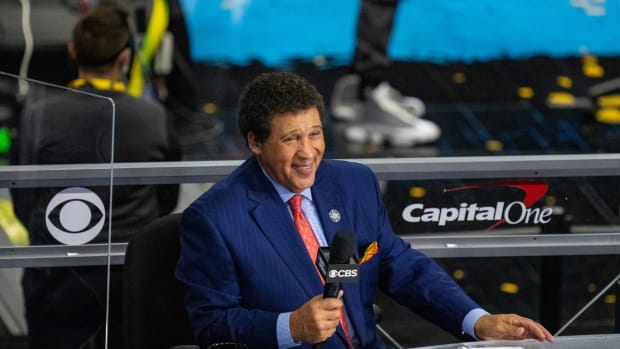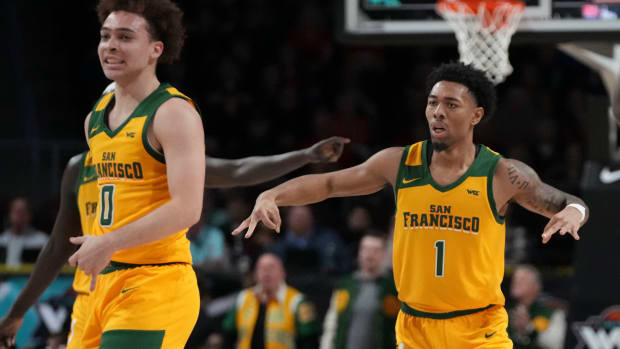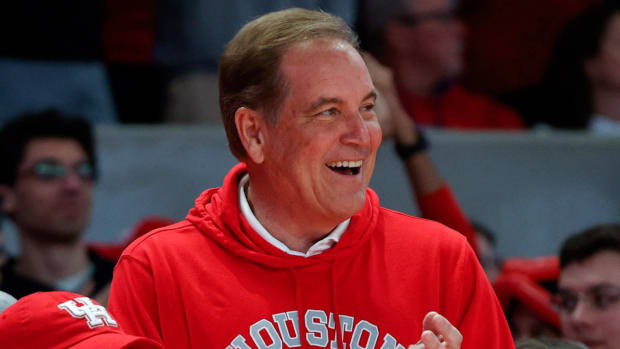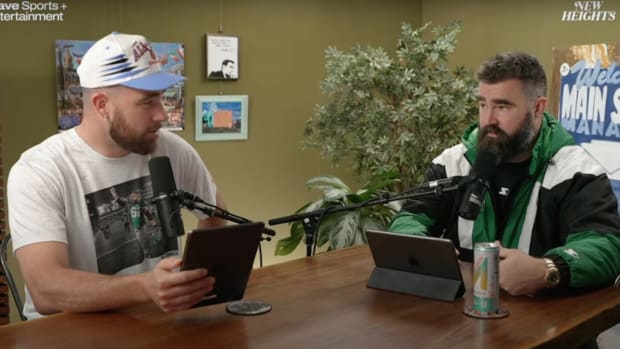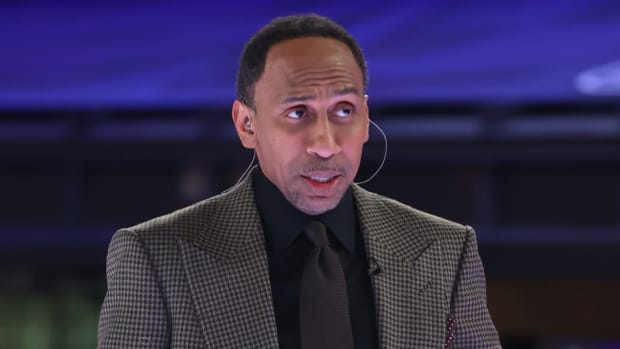Breaking Down the Hits and Misses of NBC's Broadcast of Super Bowl LII
Sixteen thoughts/impressions/reported information on NBC’s game coverage of Philadelphia’s thrilling 41-33 win over New England in Super Bowl LII.
1. Sometimes, social media can make sports fans smarter viewers. In the first quarter, game analyst Cris Collinsworth repeatedly described a play as an RPO (run-pass option) on Philadelphia’s opening drive but the production did not tell the audience (made up of many casual sports fans) what RPO was. According to Chiefs All-Pro offensive lineman Mitchell Schwartz and former NFL wide receiver Bucky Brooks, Collinsworth also incorrectly ID’d a play as an RPO twice. Helpfully, Schwartz explained what it was in a series of tweets.
With 4:12 left in the first quarter, NBC provided viewers with a definition of RPO and some stats on why it would be effective against the Patriots, which was very helpful.
“We did talk about how we were going to handle RPO because we know that the non-regular NFL fan, it would be somewhat of a foreign term,” said game producer Fred Gaudelli, in an interview with SI.com after the game. “It happened pretty quickly. I think Al did say the word run-pass option so at least we established the term. I always planned to do that graphic early in the game once the situation presented itself to me. But I didn’t want to limit Cris at the beginning if he saw it. I didn’t want to do that big graphic at the beginning of the game. I wanted the game to settle in. For the people who did not know what it was, they would get caught up.”
2. There was a jarring 45-second blackout for viewers with 7:24 left in the second quarter when NBC went to break. (Cue The Sopranos references.) Said an NBC Sports spokesperson: "We had a brief equipment failure that we quickly resolved. No game action or commercial time were missed."
What was it like in the truck? Gaudelli said the broadcast threw to the commercial and “15 seconds later my assistant director, Tim Nelson, says we have to come back there is a problem with the commercial. I said, 'OK, count me back.' At that point, I could not worry why we were back. I just had to start producing television again. We had an equipment failure in New York that we resolved quickly. We didn’t miss any game action. We didn’t miss any commercial time. While it is not the pristine telecast that you want, at the end of the day was it did not have a big effect on anything.”
3. Collinsworth and Michaels did not have a good night on predicting the officials’ decision on pass completion replays (e.g. “I think they have to overturn it,” Collinsworth said on Eagles tight end Zach Ertz game-winning touchdown catch.) After Eagles running back Corey Clement third-quarter touchdown catch was ruled complete, Collinsworth said with exasperation, “I give up. I give up. If that ball is not loose in his arms when that last foot came down, I give up. I don’t know the rule.”
Gaudelli suggested that his broadcasters were consistent with how catches had been called all year. “If you think about how the game has been called this year, Clement’s catch and Ertz’s catch, I would say a little surprising that both of them stood up. At the end of the day, I think people would love to see that as called.”
4. Michaels immediately called that the Ertz’s touchdown was going to be questionable. He referenced Steelers tight end Jesse James, who had a go-ahead touchdown overturned in Week 15 against the Patriots. That was good. Gaudelli showed 10 replays of Ertz scoring for viewers during the review as well as tri-split screen of the coaches and referee and players on the field. Viewers were not happy on social media that the broadcasters were wrong on their prediction but the production decision-making here was impressive.
5. I thought one of Gaudelli’s best decisions of the night was to let Collinsworth and Michaels (and viewers) re-watch the Clement touchdown catch after a commercial break. After looking at the play one last time, here’s what they said.
Collinsworth: “I would have called that incomplete.”
Michaels: “We have seen that called incomplete I would say the majority of the time.”
6. What did Gaudelli think of his production overall?
“It is always hard to tell until you go back and watch it but just the feel in the truck, I thought everybody performed really well,” Gaudelli said. “I thought Drew had an excellent night. I think our camera people, our replay people, our graphic people, I think they all had a really good night. I don’t think we missed any storylines and had a lot of great pictures. Obviously, we had an unbelievably exciting game to work with.”
7. Gaudelli said the pace of the game did not allow his group to do everything it wanted to do but said the tradeoff is that it makes for exciting television. “We may not be able to do every story we want to do or every element that we want to do but America does not care, they are watching a really well-played football game,” Gaudelli said. “The pace has effect. It was much easier with the Eagles because they were huddling and running the play clock down. But it was not a surprise. We prepared for that.”
8. It took NBC until midway in the first quarter to give us the info that Super Bowl XLIX game-saver and New England cornerback Malcolm Butler was not starting for the Patriots. As for the reason why, viewers did not get an update until the 11:53 remaining in the second quarter when Michaels said Butler was had not played a defensive snap due to a coaches' decision. We did get a good line by Michaels though on that: “The Patriots are telling us a coaches’ decision,” Michaels said. “Of course it was easier to get information out of East Germany before the Wall went down than to get injury information from New England.” Kudos to Gaudelli and director Drew Esocoff for the newsworthy image of Butler getting emotional during the pregame singing of "America, The Beautiful." NBC went back to update Butler at 9:23 left in the third quarter.
9. Great work by Collinsworth on the first replay of LeGarrette Blount’s 21-yard touchdown run with 8:48 left in the second quarter. He was immediately on the two blocks from center Jason Kelce that freed Blount up to score.
10. I asked Gaudelli if he would consider adding a rules analyst in the booth for NBC’s Sunday Night Football heading forward given how big the catch/no-catch rulings were in this game. “We had a former referee and a league officiating supervisor in our booth tonight,” he said. “I can’t tell you what he was saying but I think it was so close that the ultimate arbiter was going to make his decision. I think [Mike] Pereira or [Dean] Blandino could have added their opinion and Cris was doing that as well but if you take the way the catches were called during the regular season, those [Eagles catches] were outside the parameters of what he [Cris] had seen all year. As a football fan, I’d rather see it called that way. I don’t know what the rules analyst would have added on those. With Cris, we have the best and I don’t really want to take it out of his hands because he really studies the rules and knows the rules. … If it was the right, right person, sure, you could probably use it. But I don’t know if I ever want to take it out of Cris’s hands. I had no problem with what Cris said.”
11. Michaels turns 74 on Nov. 12 but he does have significant incentive if he wants to call one more Super Bowl: In calling Super Bowl LII last night, his 10th as the play-by-play voice, Michaels is one behind former CBS and FOX announcer Pat Summerall for the most Super Bowl play-by-play assignments of all time. He could tie the mark at Super Bowl LV on Feb. 7, 2021 at Raymond James Stadium in Tampa Bay, the next Super Bowl broadcast for NBC.
12. NBC debuted a new score bug and graphics package. Gaudelli said that will be the package next year for SNF. "We just want graphics that you are not going to see at 1:00 or 4:00," he said. "We want them to be eye-grabbing yet they have to be readable. I thought it had a lot of style to it and pretty easily readable.”
13. Michaels made some uncharacteristic flubs including calling Mike Trout a “California Angel,” proclaiming that Patriots defensive coordinator Matt Patricia was going to coach the Pistons in 48 hours, and declaring New England had its lead when the game was tied and they needed an extra point for the lead. On the plus side, Michaels used some humor to correct those errors quickly.
14. The booth was selling the soap pretty hard for Justin Timberlake, no?
15. Thought Michaels had a very unmemorable final call of the last play, which admittedly was an awkward sequence given a deflection in the end zone on a Hail Mary. His call: “Brady under pressure. Escapes the sack. Launching one for the end … zone. It is a jump ball. And it is incomplete. And Gronk was there (laughs). And time runs out.”
16. The absolute best Super Bowl commercial … was an ad for the NFL.
THE NOISE REPORT
(SI.com examines some of the week’s most notable sports media stories)
1. On Monday morning, NBC issued a press release that said the game drew a 47.4 overnight rating, down 3% from last year's overnight. The game peaked with a 52.2/74 overnight rating in the fourth quarter (10-10:15 p.m. ET).
The halftime performance by Justin Timberlake (8:15-8:30 p.m. ET) delivered a 48.1 overnight. Viewership numbers will come out later on Monday. Given the ratings drops for the league during the regular season and postseason and the overall declines in linear viewing, the NFL and NBC should be very happy with a small drop.
1a. Here were the top 11 TV markets for the Super Bowl:
Buffalo, 56.4
Philadelphia, 56.2
Boston, 55.9
Minneapolis-St. Paul, 54.9
Pittsburgh, 54.9
Norfolk, 53.9
New Orleans, 53.0
Providence, 52.5
Milwaukee, 52.3
Seattle, 52.2
Kansas City, 52.2
1b. NBC Sports Chairman Mark Lazarus was asked this week whether he envisioned a day where the Super Bowl did not air on an over-the-air network. He said he does not see it.
“What I see and what is happening is the NFL continues to be a broadcast-centric league, and I think that has helped them maintain and grow as the largest media property in the world,” Lazarus said. “But what’s been added along the way are other platforms. So the games are now streamed as well as being on linear television, and I think the goal there is to make this game, in particular, accessible to everybody in the United States as it relates to our world and the league. Works internationally as well. But I think what you see as linear will always be the base, will always be the biggest. It will maintain its dominance, but you’ll see platforms added along the way in conjunction with the media partners such as ourselves.”
1c. The front page wrap of Monday's Philadelphia Inquirer
2. Episode 160 of the Sports Illustrated Media Podcast features two guests: ESPN investigative reporter Paula Lavigne and The MMQB editor and NFL reporter Peter King. In this podcast, Lavigne discusses her recent ESPN Outside The Lines story on Michigan State that found “a pattern of widespread denial, inaction and information suppression of [sexual assault, violence and gender discrimination] allegations by officials ranging from campus police to the Spartan athletic department”; the timeline regarding the reporting for the story and when and where the story originated; how universities use a delay tactic on reporters attempting to obtain public records; the challenges of finding records on Baylor’s athletics department; her approach to FOIA requests and obtaining documents; whether she interacts with the programming side of ESPN; her thoughts on Michigan State football coach Mark Dantonio and Michigan State basketball coach Tom Izzo’s reactions and denials regarding her reporting; criticism in some quarters that ESPN is taking advantage of the publicity of the Larry Nassar case to pile on Michigan State; the future of investigative work at sports media outlets; how we should we look at sexual assault and college athletes and much more. King discusses how he approaches his The MMQB podcast; his two-part podcast interview with Tom Brady at Brady’s home; how he books his podcast's guest; why the podcast medium gets NFL people to open up more; what football podcasts he listens to regularly and much more. To listen to the podcast in full, check it out on Apple Podcasts and Stitcher.
3. The forever-moving Thursday Night Football package, with multiple short-term marriages over the years, has found a new domestic partner: Fox Sports. Last Wednesday the NFL and Fox jointly announced a five-year rights agreement to broadcast Thursday Night Football on Fox’s over-the-air network. The news was first reported on Tuesday night John Ourand of the Sports Business Daily and Bloomberg News. Ourand reported that Fox will pay an average of $550 million per year through the 2022 season, which makes the conclusion of the Thursday Night Football deal concurrent with the other NFL TV rights deals. Here are the details of the deal.
4. Sports pieces of note:
• Stunning story from Ted Jackson of NOLA.com and the best sports story I have read in 2018: The search for Jackie Wallace.
• After the cheering stops. "I’m the Wife of a Former N.F.L. Player. Football Destroyed His Mind." By Emily Kelly.
• Brendan Quinn of The Athletic on what happened at Michigan State.
• From The Idaho Statesman: Racist letter warns Idaho youth soccer coach to ‘be careful.’ Instead, he’s fighting back. By Michael Lycklama.
• Why Koreans Are So Good at Speedskating. From Jay Caspian Kang of The New York Times.
• SI’s Lee Jenkins profiled Lou Williams of the Clippers.
Non sports pieces of note:
• Politico's Molly McKew shows how computational propaganda and information warfare are used to promote a destructive narrative against the American mind—and change the face of US politics.
• From Splinter’s Molly Osberg: How not to die in America.
• From Jamie Thompson of the Dallas Morning News: How the Dallas SWAT team cornered and killed the July 7 police shooter.
• From The New Yorker’s Rachel Aviv: What does it mean to die.
• Via California Sunday’s Mark Arax: Stewart Resnick is the biggest farmer in the United States, a fact he has tried to keep hidden while he has shaped what we eat, transformed California’s landscape and ruled entire towns.
• From CJR’s Howard R. Gold: Who killed Time Inc.?
• Via Matthew Dolan and David Jesse of The Detroit Free Press: “In Donors We Trust."
• From The Washington Post: What Trump’s address sounded like in eight American living rooms.
• From Buzzfeed’s Alexander Chee: My Inheritance Was My Father’s Last Lesson To Me And I Am Still Learning It.
• Via Chico Harlan of The Washington Post: ‘Bitcoin is my potential pension’: What’s driving people in Kentucky to join the craze.
•The Atlantic’s Ed Yong: The CDC Is About to Fall Off a Funding Cliff.
5. Striking digital ad from The New York Times on its concussion coverage.
5a. Fox Sports’ promising “Magnify” documentary series recently placed a documentary about the Brazilian soccer team Chapecoense, at the SXSW film festival in March. The film, Nossa Chape, is directed by Jeff Zimbalist and Michael Zimbalist, who directed the “30 for 30 docs,” The Two Escobars and Youngstown Boys.
5b. Final numbers for last week’s All-Star Games:
The Pro Bowl: 8,553,000 viewers
The NHL All-Star Game: 2,031,000 viewers.
5c. Saints radio announcer Jim Henderson is stepping down after more than three decades in the booth.
5d. Longtime sports broadcaster and historian David J. Halberstam has a new website dedicated to sports media: Sports Announcers Report Card.
